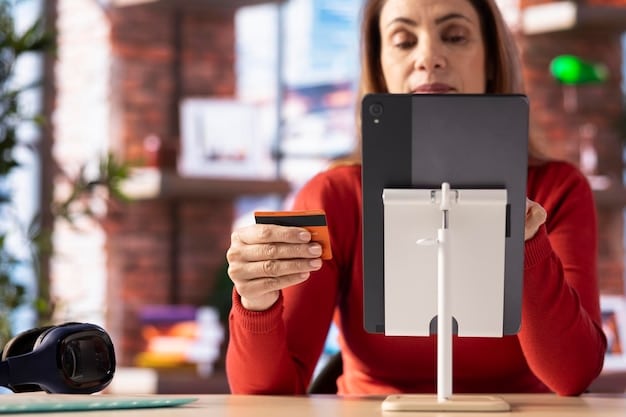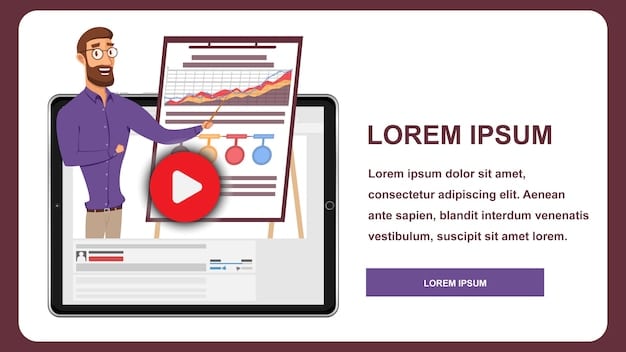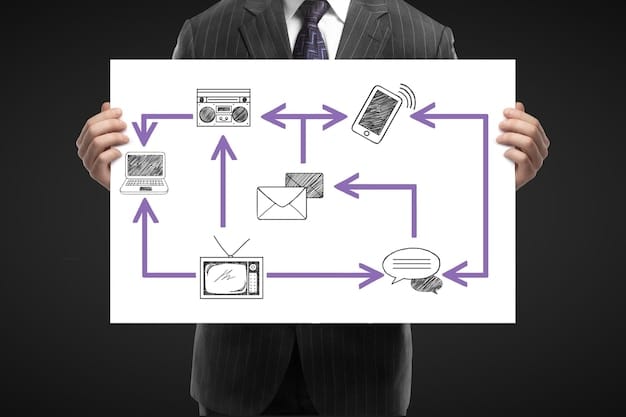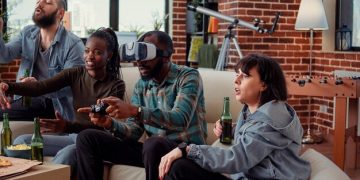YouTube Copyright Policies Update: Protecting Content in 2025

YouTube’s updated copyright policies for 2025 aim to provide clearer guidelines and enhanced tools for creators to protect their content and avoid copyright strikes, ensuring a fairer and more transparent platform for everyone.
Navigating the ever-evolving landscape of YouTube requires creators to stay informed about the latest copyright policies. Understanding YouTube’s **YouTube’s Updated Copyright Policies: Avoid Strikes and Protect Your Content in 2025** is crucial for maintaining a healthy channel and avoiding potential legal issues.
Understanding YouTube’s Copyright System
YouTube’s copyright system can seem complex, but understanding its core components is vital for every content creator. This system is designed to protect copyright holders while allowing fair use of copyrighted material.
Copyright Basics
Copyright law grants creators exclusive rights over their original works, including videos, music, and artwork. These rights include the ability to reproduce, distribute, and display their work publicly.
How YouTube Detects Copyright Infringement
YouTube uses two primary systems for detecting copyright infringement: Content ID and manual copyright claims. Content ID automatically scans uploaded videos against a database of copyrighted material, while manual claims are submitted by copyright holders who find their work being used without permission.
- Content ID: An automated system that scans uploads against a database of copyrighted material.
- Manual Claims: Copyright holders can submit claims if they find their work being used without permission.
- Copyright Strikes: Receiving three copyright strikes can result in permanent channel termination.
Staying informed about these systems can help you avoid unintentional copyright infringement and protect your own content effectively.

Key Changes in YouTube’s 2025 Copyright Policies
YouTube regularly updates its copyright policies to reflect changes in copyright law and to address the needs of both creators and copyright holders. The 2025 updates include several key changes that creators should be aware of.
Enhanced Fair Use Guidelines
The updated policies provide clearer guidelines on what constitutes fair use, helping creators understand how they can use copyrighted material for purposes such as criticism, commentary, and education without infringing copyright.
Improved Dispute Resolution Process
YouTube has streamlined the dispute resolution process, making it easier for creators to challenge copyright claims they believe are unwarranted. This includes providing more transparency and faster response times.
These improvements aim to create a fairer system for all parties involved, promoting a more balanced approach to copyright enforcement.
How to Avoid Copyright Strikes
Avoiding copyright strikes is essential for maintaining a healthy YouTube channel. Understanding the common causes of strikes and implementing preventative measures can significantly reduce your risk.
Understanding Common Copyright Infringements
One of the most common causes of copyright strikes is using copyrighted music without permission. This includes using popular songs in your videos without obtaining the necessary licenses.
Best Practices for Using Copyrighted Material
If you need to use copyrighted material, always seek permission from the copyright holder. This could involve obtaining a license or seeking explicit consent.
- Obtain Licenses: Secure necessary licenses for using copyrighted music or video clips.
- Seek Permission: Contact copyright holders to request permission for using their work.
- Use Royalty-Free Content: Utilize royalty-free music and stock footage from reputable sources.
By following these best practices, you can minimize your risk of receiving a copyright strike and protect your channel from potential penalties.

Protecting Your Own Content
Protecting your own content is just as important as avoiding copyright strikes. Taking proactive steps to safeguard your videos can prevent unauthorized use and potential revenue loss.
Registering Your Copyright
Registering your copyright with the U.S. Copyright Office provides legal protection for your work and allows you to take action against infringers.
Using YouTube’s Content ID System
If you own the copyright to original material, you can submit it to YouTube’s Content ID system. This will allow YouTube to automatically scan uploaded videos and identify any unauthorized uses of your content.
Implementing these measures can help you maintain control over your content and ensure that you receive proper credit and compensation for your work.
Fair Use and Copyright: What You Need to Know
Fair use is a legal doctrine that allows limited use of copyrighted material without permission from the copyright holder. Understanding the boundaries of fair use is crucial for avoiding copyright infringement.
The Four Factors of Fair Use
The U.S. Copyright Act outlines four factors that courts consider when determining whether a particular use of copyrighted material is fair:
- The purpose and character of the use, including whether such use is of a commercial nature or is for nonprofit educational purposes
- The nature of the copyrighted work
- The amount and substantiality of the portion used in relation to the copyrighted work as a whole
- The effect of the use upon the potential market for or value of the copyrighted work
Examples of Fair Use
Common examples of fair use include criticism, commentary, news reporting, teaching, scholarship, and research. However, these uses must be balanced against the four factors mentioned above.
By understanding these principles, creators can make informed decisions about using copyrighted material and avoid potential legal issues.
Monetization and Copyright
Copyright issues can significantly impact your ability to monetize your YouTube videos. Understanding how copyright claims affect monetization is essential for maximizing your revenue.
How Copyright Claims Affect Monetization
If a video contains copyrighted material, the copyright holder may choose to monetize the video, effectively taking a portion of your ad revenue. In some cases, they may even choose to block the video entirely.
Strategies for Monetizing Copyrighted Content Legally
If you want to use copyrighted material and still monetize your videos, you may need to obtain a license or seek permission from the copyright holder. Alternatively, you can create original content that does not infringe any copyrights.
By taking these steps, you can increase your chances of monetizing your videos without running into copyright issues.
| Key Point | Brief Description |
|---|---|
| 🔑 Understanding Copyright Basics | Copyright law protects creators’ exclusive rights over their original works. |
| 🛡️ Avoiding Copyright Strikes | Obtain licenses, seek permission, or use royalty-free content. |
| 🔒 Protecting Your Content | Register your copyright and use YouTube’s Content ID system. |
| ⚖️ Fair Use | Limited use of copyrighted material without permission, considering four factors. |
Frequently Asked Questions (FAQ)
▼
A copyright strike is a warning YouTube issues when a copyright holder notifies them that you’ve used their copyrighted material without permission. Accumulating three strikes can result in the termination of your channel.
▼
To avoid copyright strikes, always get permission from the copyright holder before using their material, use royalty-free content, or ensure your use falls under fair use. Regularly check your videos for potential copyright issues.
▼
Content ID is an automated system that allows copyright holders to identify and manage their content on YouTube. It scans uploaded videos against a database of copyrighted material and can result in copyright claims.
▼
If you receive a copyright claim, review it carefully. If you believe it’s unwarranted, you can dispute the claim. If you used the material without permission, you can remove the copyrighted content.
▼
Fair use allows limited use of copyrighted material without permission for purposes like criticism, commentary, and education. YouTube considers fair use claims, but creators need to understand its limitations and factors.
Conclusion
Staying informed about YouTube’s updated copyright policies is crucial for protecting both your channel and your content. By understanding the basics of copyright law, utilizing YouTube’s tools, and following best practices, creators can navigate the complexities of copyright and create a thriving online presence.





